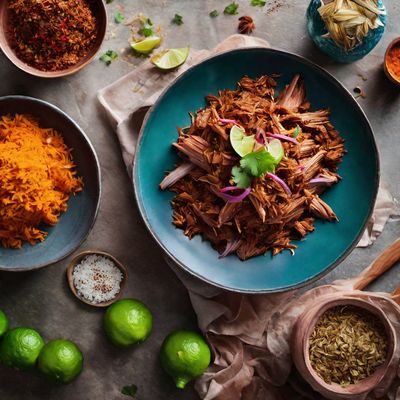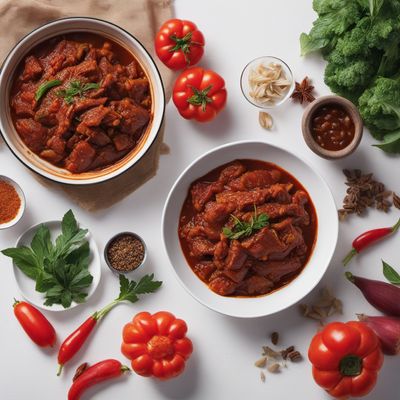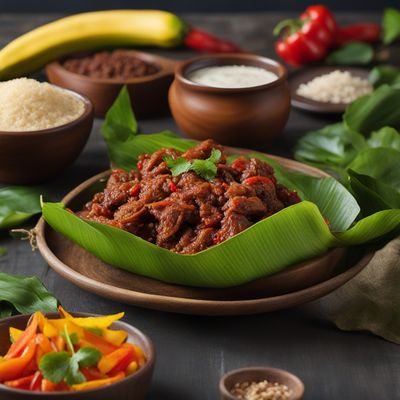
Ingredient
Annatto seed
The Vibrant Allure of Annatto Seed
Annatto seeds are small, triangular seeds derived from the achiote tree, native to tropical regions of the Americas. They are known for their bright red-orange color, which is imparted to dishes when the seeds are infused in oil or used as a natural food coloring. In terms of flavor, annatto seeds have a mild, slightly peppery taste with a hint of nuttiness.
Origins and history
Annatto seeds have a long history of use in Latin American, Caribbean, and Filipino cuisines. They were traditionally used by indigenous cultures as a natural dye for textiles and body paint. Over time, their culinary applications expanded, and they are now widely used as a coloring agent and flavor enhancer in various dishes. Annatto seeds are also valued for their potential health benefits, as they contain antioxidants and anti-inflammatory compounds.
Nutritional information
Annatto seeds are a good source of antioxidants, including carotenoids, which have been linked to various health benefits. They are also rich in vitamin E and contain small amounts of minerals such as calcium and iron. Additionally, annatto seeds are low in calories and fat.
Allergens
Annatto seeds are not known to be allergenic. However, individuals with known allergies to seeds or nuts should exercise caution and consult with a healthcare professional if they have any concerns.
How to select
When selecting annatto seeds, look for whole seeds that are bright red-orange in color. Avoid seeds that appear dull or have a musty odor, as this may indicate that they are past their prime. It is also helpful to purchase annatto seeds from reputable sources that specialize in spices and herbs to ensure their quality and freshness.
Storage recommendations
To maintain the freshness and quality of annatto seeds, store them in an airtight container in a cool, dry place away from direct sunlight. This will help preserve their vibrant color and prevent them from becoming stale. It is recommended to use annatto seeds within a year of purchase for the best flavor and potency.
How to produce
Annatto trees can be grown in tropical regions with a warm climate. They require well-drained soil and regular watering. The seeds can be harvested by collecting the seed pods from the tree and extracting the seeds. However, due to the specific growing conditions required, it is best to leave the production of annatto seeds to experienced growers.
Preparation tips
Before using annatto seeds, they need to be infused in oil or water to extract their vibrant color and flavor. This can be done by heating the seeds in oil or water until they release their color, then straining the liquid to remove the seeds. The resulting infused oil or liquid can be used in a variety of dishes, such as rice, stews, soups, or marinades. Annatto seeds can also be ground into a powder and used as a natural food coloring.
Culinary uses
Annatto seeds are commonly used in Latin American dishes such as achiote paste, which is used as a marinade or seasoning for meats and poultry. They are also used to add color and flavor to dishes such as rice, soups, stews, and sauces. In Filipino cuisine, annatto seeds are used in dishes such as kare-kare, a peanut-based stew, and pancit palabok, a noodle dish. Additionally, annatto seeds are used as a natural food coloring in various products, including cheese, butter, and margarine.
Availability
Annatto seeds are primarily cultivated in tropical regions of the Americas, including countries such as Mexico, Brazil, Peru, and the Dominican Republic. They are also commonly available in international grocery stores or specialty food shops that carry a variety of spices and herbs.
More ingredients from this category
Recipes using Annatto seed » Browse all

Puerto Rican-style Chicken Soup
Sopa de Pollo Puertorriqueña - A Hearty Puerto Rican Chicken Soup

Maltese-Style Som Tam Khai Khem
Zesty Maltese Papaya Salad with Salted Eggs

Crispy Masala Papad Delight
Spice up your palate with Crispy Masala Papad Delight

Caribbean Bresaola Mousse
Tropical Delight: Caribbean Bresaola Mousse

Cochinita Pibil - Nouvelle Cuisine Style
Tender and Flavorful Slow-Roasted Pork in a Delicate Nouvelle Cuisine Twist

Kapampangan-style Kouneli Stifado
Savory Kapampangan Rabbit Stew

Bok l'hong with a Twist
Tropical Delight: Refreshing Bok l'hong Salad

Muisca-style Arroz Aguado
Golden Rice Delight: A Muisca Twist on Arroz Aguado

Papua New Guinean Tropical Salad
Island Delight: A Refreshing Papua New Guinean Tropical Salad

Tolimense Tamales with a Twist
Colombian Delight: Tolimense Tamales with a Modern Twist

Sopa de Pollo y Fideos Adapted to Puerto Rican Cuisine
Sopa de Pollo y Fideos Puertorriqueña: A Hearty Puerto Rican Chicken Noodle Soup

Venezuelan Hallacas: A Traditional Delight Wrapped in Banana Leaves
Savory Delights: Unveiling the Flavors of Venezuelan Hallacas
